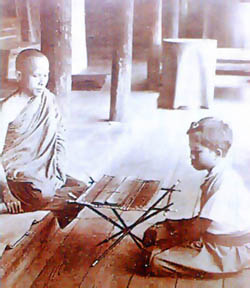
Basic education originated in Buddhist monastery
compounds. |
In the early days
of Thai history, education primarily revolved around two institutions, one
religious and the other royal. Buddhist monks gave basic education to boys
in schools set up within the compounds of monasteries, while children of the
royal household and from families of the nobility were educated in order to
serve in the court and govern in the provinces. Very few women were given an
opportunity to attend school and to become literate. The mass of society was
made up of farmers, who saw little need for literacy; village history. lore.
and local philosophy were transmitted orrally.
During the reign of King Rama V(1868-1910) there was increased recognition
of the need for educated people to staff the growing bureaucracy. As a
result, the Thai education system was modernized and made more accessible to
the general public. This began with the 1898 education proclamation, which
was strongly influenced by the British system and in which two educational
paths were stipulated, the academic and the vocational. The influence of
American and Japanese systems could be discerned in the education
proclamation of 1902, which provided for higher education.
The first formal comprehensive education plan was introduced in 1932, the
same year the monarchy became constitutional. This plan highlighted four
years of elemendtary education and eight years of secondary schooling. This
system was further refined in 1936, when five levels of education were
featured; preprimary or kindergarten, primary, secondary, preuniversity, and
higher education. The educational plan of 1951 was noteworthy in that it
facilitated special and adult education.
As part of the emphasis on national development since 1960, a major goal of
the educational system has been to harmonize and comply with economic and
political plans. The government faced the challenge of widespread illiteracy,
as well as the massive task of training young men and women for the dynamic
development process in the shortest time possible. Recently it has had to
modify instruction to include the specialized skills required by industries
such as computer science and environmental engineering, together with new
branches of medicine. The most recent changes were broguht about by the
educational plan of 1977, which calls for six years of compulsory primary
schooling, three years of lower secondary schooling, and another three years
of upper secondary education for those who plan to enter special occupations
or a university. This system was launched in May 1978, beginning with the
first grade at both the primary and secondary levels, and continued until
the cycle of six grades at both levels was fully implemented in 1983.
Efforts to adapt to the development needs in technology and advanced
agricultural methods now suggest a possible future system in which the
six-year primary schooling will be extended to nine years, following by
three years of secondary education and four years of college or university. |